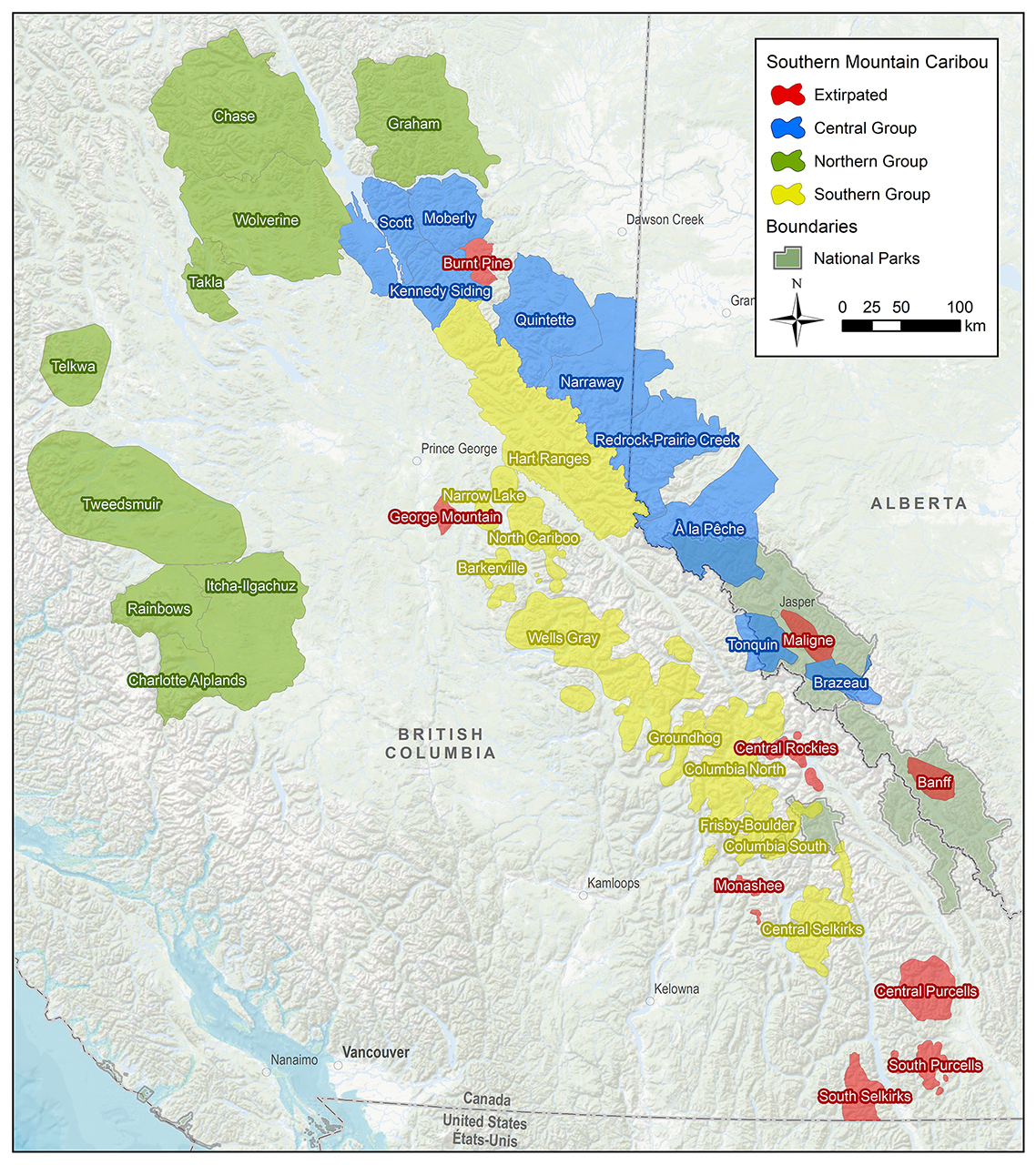
Caribou habitat
Jasper National Park
Where they live
Southern mountain caribou herds are found in the mountain regions of Western Canada. Their habitat includes parts of Banff, Jasper, Mount Revelstoke and Glacier national parks. There are four caribou populations with habitat in Jasper National Park: the À la Pêche, Brazeau, Maligne and Tonquin. There has been no sign of the last members of the Maligne herd since 2018.
Caribou can be found in the Tonquin Valley, the Brazeau mountain ranges near the Icefields Parkway, and on either side of Jasper National Park’s northern boundary. Historically, animals from the Tonquin, Maligne, and Brazeau herds likely overlapped at different times of the year. DNA evidence indicates that they may have also interacted with the Banff and Columbia North herds.

Map showing the distribution of southern mountain caribou herds in British Columbia and Alberta. Southern mountain caribou range and groupings are designated in the “Recovery Strategy for the Woodland Caribou, Southern Mountain population (Rangifer tarandus caribou) in Canada (2014).”
Mountain caribou travel between summer and winter ranges throughout the year. The main reasons caribou move between different types of habitat are to avoid predators and to find food.
Spring and summer

In spring, mountain caribou seek out areas where the snow is not so deep and they can find early spring shoots to eat. This sometimes brings caribou into the valley bottoms near the Icefields Parkway or Highway 16. In late May and early June, caribou cows ready to give birth to calves isolate themselves from predators by trekking into remote, higher-elevation alpine and subalpine habitat. This is also where mountain caribou spend most of their time during summer.
Fall and winter

In fall, mountain caribou gather together in larger groups for the rutting (or mating) season. They separate back into smaller groups as winter sets in. During winter, mountain caribou spend time both in the alpine and below the treeline. The deep snow helps them avoid predators, and they can dig through the snow in subalpine forests and on windswept slopes for ground lichens to eat.
Critical habitat for caribou
Critical habitat is defined as “the habitat that is necessary for the survival or recovery of a listed wildlife species” under Canada’s Species at Risk Act and it is identified in the recovery strategy or an action plan for the species.
About 86% of land in Jasper National Park is considered critical habitat for caribou - more than 9,600 km2. Critical habitat for southern mountain caribou includes different types of ranges.
Caribou in Jasper have summer and winter ranges at high elevations. Summer ranges feature subalpine forests and alpine. Winter ranges feature alpine slopes, subalpine forests, as well as low-elevation forests, meadows, wetlands and lakes.
Habitats outside of summer and winter ranges are called matrix ranges. There are two types of matrix ranges. Type 1 matrix ranges are areas that caribou use to move between summer and winter ranges. Type 2 matrix ranges are areas near or bordering summer, winter or Type 1 matrix ranges, that provide connectivity between caribou subpopulations. Matrix ranges are considered critical habitat for caribou because changes within these ecosystems may influence the ability of mountain caribou to avoid predators, find food, or be undisturbed.

Map of critical habitat for southern mountain caribou in Jasper National Park (defined in the 2014 Recovery Strategy for the Woodland Caribou, Southern Mountain population in Canada). The map shows core high-elevation habitats in summer and winter ranges and matrix ranges. Matrix ranges include areas caribou use as routes between their summer and winter ranges (Type 1 matrix), and areas that surround summer and winter ranges and the routes between them (Type 2 matrix).
For more information about critical habitat for southern mountain caribou, visit the Species at Risk Public Registry: Recovery Strategy for the Woodland Caribou, Southern Mountain population in Canada (see section 7, Appendix B & C)
- Date modified :